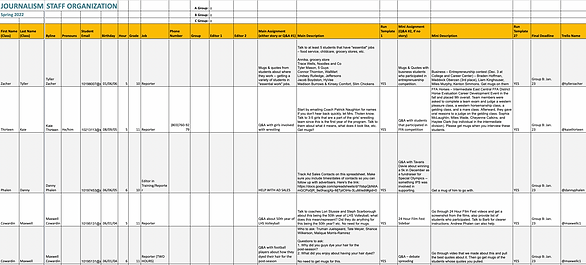
Editing, Leadership and Team Building
Taking on an editor-in-chief role was one of the most difficult and rewarding decisions I ever made. Running a staff of more than 60 people was a constant challenge in management and team building. Those 60 people also became my closest friends and family.

Editor-in-Training
This year I helped spearhead a new program for our staff, which allows young journalists to apply for an editor-in-training position. This position is made to help bridge the gap between the responsibilities of a staffer and the increased role of an editor. It allows editors to help work with staffers in a hands-on role on leadership methods and other editorial techniques.
What my staffers say about me
Editing
Editing stories was a more difficult challenge this year than in the past. Due to COVID-19, many staffers had a lot less experience with AP style and reporting than usual. We also had to teach the basics to even some of our experienced reporters, as nearly all staffers who joined during the pandemic hadn’t had a chance to conduct in-person interviews. That meant editing stories wasn't just about commas and quotations, it was about training a whole group of writers for the future.

Team building and staff bonding
Organization and Workflow
Our group of editors leads more than 60 staffers to produce three publications – no small task for a group of high schoolers. It is crucial that we maintain our organization and use the tools in our pocket to help make sure everything stays running.
Cycles
Our staff runs on cycles of a few weeks to finish assignments. Knowing when these cycles land and how they work is crucial to make sure we have all the content we need for our publication deadlines and keeping staffers on track. Here are some charts I made outlining a cycle system I came up with to organize all of our staffers.

Communication
If there is one thing that is crucial to our staff, it's communication. All of our staffers work on the same publications and our editors constantly help out the other publications. We aren't separated. This is helpful because it allows all of our staff's unique talents to be used in different places. For example, a yearbook editor and I broke a news story this year for the website, even though both of us are technically editors for other publications. But at LHS, it's an all-hands-on-deck approach. This means communication is key. Here is a look at Webex, our communication platform being used for communication during a breaking news story draft.
Communication is such a focus of our staff, it ended up being the center of our entry for the National Scholastic Press Association Innovation Pacemaker.
Our entry, made by our staff's editors, can be found here: https://express.adobe.com/page/qedoNjfbPtgGx/



Assignments
Assignments are obviously the lifeblood of our staff, they are what all of our content runs through, so making sure we give out the correct assignments and due dates is crucial. Here is the process my editors and I use:
1. Editor meeting to decide assignments. The editors and I meet on Sunday nights to work through staff story pitches and brainstorm for our publications to create a list of assignments for our staffers. We then work through what assignments are best for which staffers until we have a complete list of assignments.
2. Check with our adviser. After the editors have determined assignments, we run our decisions past our adviser and make sure that everything looks good.
3. Give out assignments and due dates. The final step is making sure everyone knows their assignments and when they are due. We use a program called Trello to organize all of our assignments and also go through them in class on Monday.
4. Check with staffers throughout the week. Our job as editors is to always make sure we are engaging with our staffers and checking in on their work. Making sure we are always available for questions or training is important to make sure assignments get done on time and staffers improve.
5. Deadline day. The final step is on deadline day when we check off assignments that are completed and work with staffers who are behind to catch up or make alternate plans.




Page Planning
As print newspaper editor-in-chief, it's my job to make sure that 32 pages are filled with inspiring, correct and informative journalism. This can be a daunting challenge, but using Trello, I can lay out what pages look like and the content we want throughout the newspaper, which isn't just helpful for me, but is a good reference for all of our staffers when working on the newspaper.
It's also important that we always have a photo of a dog in the background, because who doesn't love dogs?



